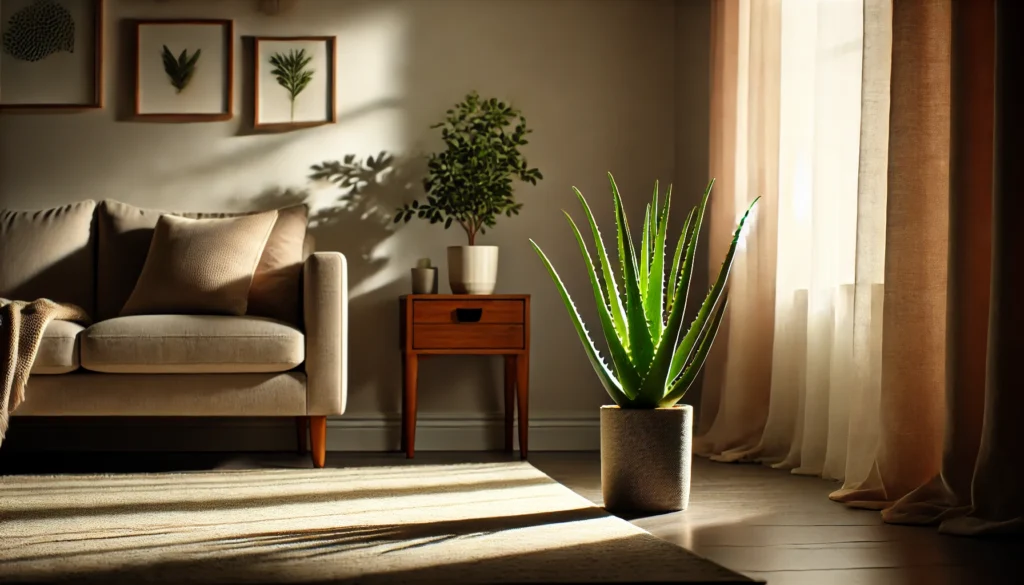
Essential Guide to Caring for Aloe Vera in Minimal Sunlight: Tips for Healthy Growth
Aloe vera is a resilient and versatile plant, beloved for its healing properties and low-maintenance nature. But what happens when your aloe vera is exposed to minimal sunlight? Many plant owners face this challenge, wondering how to keep their aloe thriving in less-than-ideal light conditions. If you’re wondering how to properly care for aloe vera in minimal sunlight, you’re in the right place. In this guide, we’ll provide expert tips on how to keep your aloe healthy, vibrant, and flourishing—whether you’re placing it in a dimly lit room or an area with limited natural light.
Table of Contents
ToggleUnderstanding Aloe Vera’s Light Needs
Caring for aloe vera in minimal sunlight can be challenging, but it’s possible with the right approach. Aloe vera thrives in bright, indirect light, but if you have limited sunlight, you’ll need to make some adjustments to keep your plant healthy.
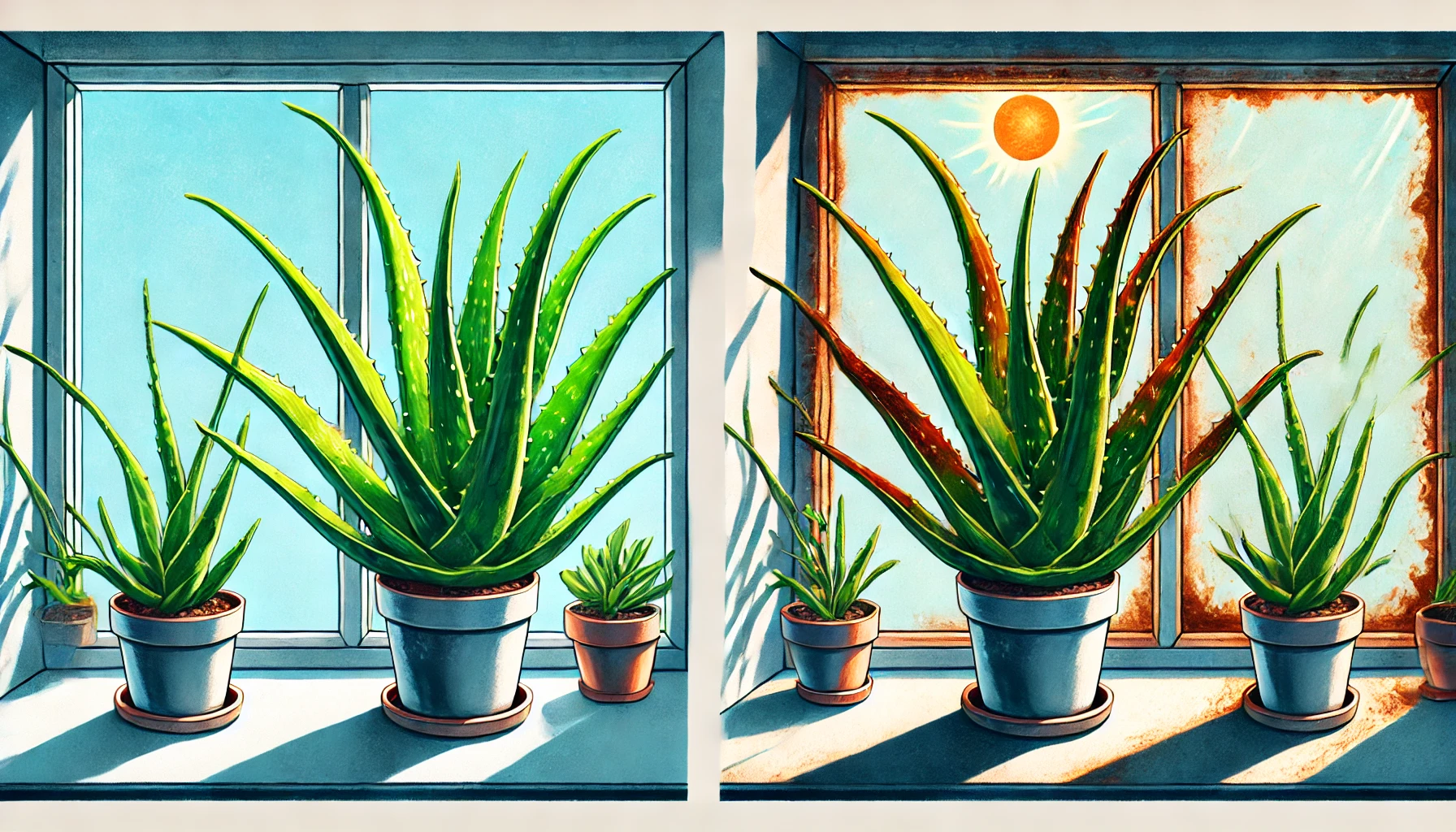
How Much Light Does Aloe Vera Need?
Ideally, aloe vera requires at least 6 hours of sunlight daily. In low-light conditions, it can still survive, but growth may slow down. If natural light is scarce, placing the plant near a bright window or using artificial grow lights can help.
Best Indoor Spots for Aloe Vera
Near South- or West-Facing Windows: These locations provide the most natural light.
Under Grow Lights: Full-spectrum LED or fluorescent grow lights mimic sunlight and support healthy growth.
Bright, Shaded Areas: Avoid direct exposure to harsh artificial lights that may dry out the plant.
Signs of Light Deficiency
If your aloe vera is not getting enough light, you may notice:
Stretching (Etiolation): The leaves become long and leggy.
Pale or Yellow Leaves: Lack of chlorophyll production due to low light.
Weak Growth: The plant may stop producing new leaves.
To successfully care for aloe vera in minimal sunlight, ensure it receives supplemental lighting and monitor its growth closely. With proper care, it can still thrive indoors, even in low-light environments.
How Minimal Sunlight Affects Aloe Vera
Caring for aloe vera in minimal sunlight requires special attention, as this hardy succulent thrives in bright, indirect light. While aloe vera can tolerate low-light conditions, insufficient sunlight slows its growth, weakens its structure, and can cause leggy, pale leaves.
Growth Stagnation:
In low-light conditions, Aloe Vera’s growth slows down. It may stop producing new leaves or fail to reach its full potential. While it can survive with limited sunlight, it won’t grow as vigorously.
Color Changes:
Aloe Vera plants that don’t get enough light may lose their vibrant green color, turning pale or yellow. This is a sign of stress and indicates that the plant isn’t getting the energy it needs to thrive.
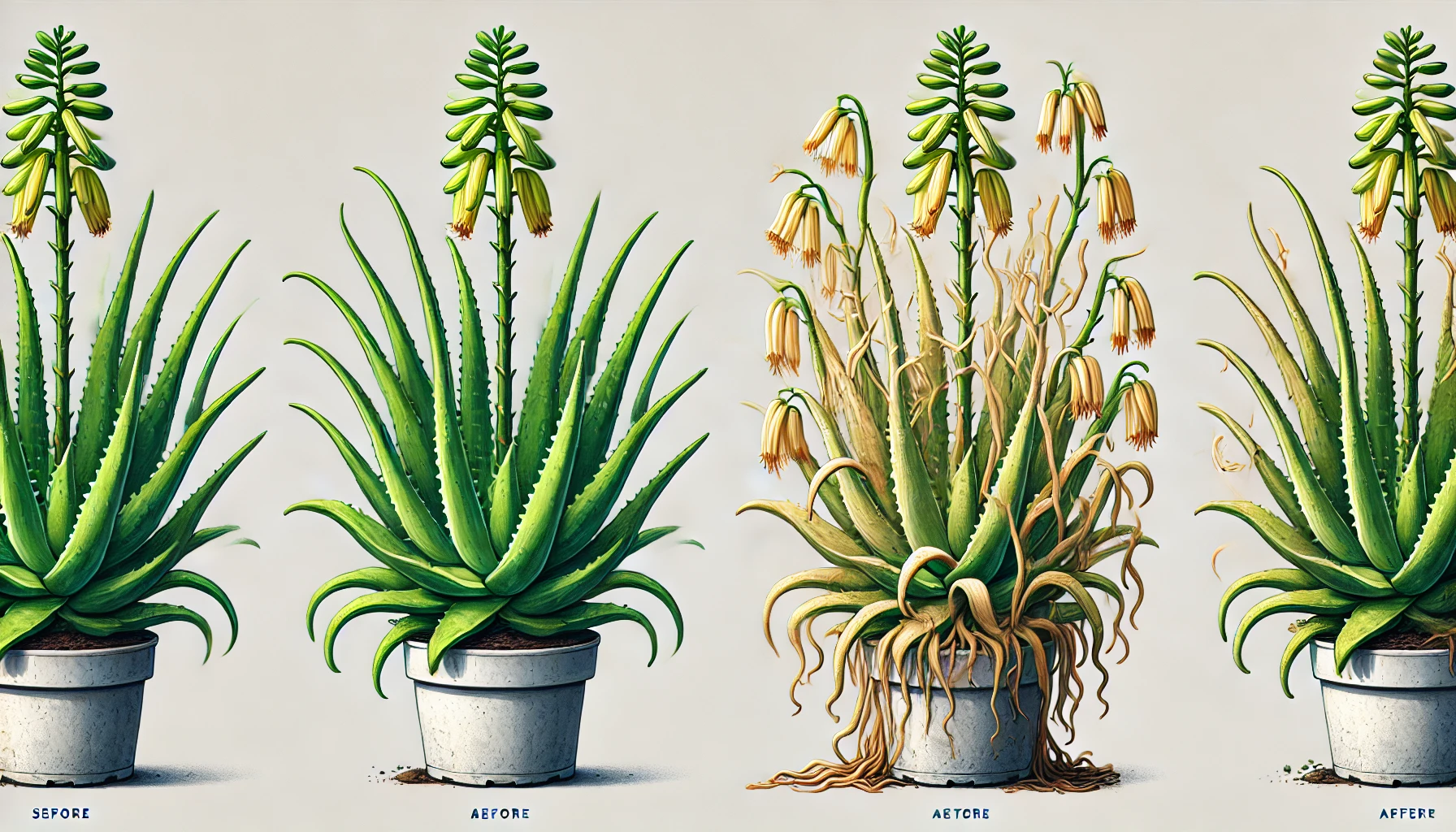
Leggy Growth:
In search of more light, Aloe Vera may become “leggy,” meaning its leaves grow longer and thinner, with noticeable gaps between them. This can affect the plant’s aesthetic appeal and overall health.
Increased Susceptibility to Disease:
Low light can weaken Aloe Vera’s immune system, making it more vulnerable to pests and diseases. A healthy, well-lit Aloe is much more resistant to issues like fungal infections.
Optimal Light for Aloe Vera:
To keep your Aloe Vera plant healthy, place it in a spot that receives indirect, bright sunlight for 6-8 hours a day. If natural sunlight is limited, consider using grow lights to provide the necessary light for growth.
By understanding how minimal sunlight affects Aloe Vera, you can adjust its environment to ensure it thrives and continues to provide its healing benefits.
Finding the Right Location for Aloe Vera in Low Light
Caring for aloe vera in minimal sunlight requires careful placement to ensure healthy growth. While aloe vera thrives in bright, indirect light, it can still survive in low-light conditions with proper care. The key is to choose a spot that provides enough ambient light without exposing the plant to darkness for extended periods.
Understanding Aloe Vera’s Light Needs:
Aloe Vera naturally grows in sunny, desert-like environments, so it requires plenty of indirect light to thrive. However, it can tolerate lower light levels, although it may grow slower and may not produce as many pups (offsets).

Best Low-Light Locations:
Place your Aloe Vera near a window that receives indirect sunlight, such as a north or east-facing window. If direct sunlight is limited, try positioning the plant on a shelf or table where it can still catch some natural light during the day.
Avoid Total Darkness:
Even in low-light conditions, Aloe Vera cannot survive in total darkness. It needs some light, so avoid placing it in rooms with no natural light or far from windows.
Artificial Lighting Option:
If your home lacks sufficient natural light, you can use grow lights. Choose full-spectrum LED lights to simulate natural sunlight and keep the Aloe Vera healthy. Place the plant about 6-12 inches away from the light source to mimic outdoor conditions.
Signs of Too Little Light:
If your Aloe Vera is not getting enough light, you might notice that it starts to stretch out (etiolate), with long, weak stems and smaller leaves. The color may also fade, and the plant may become leggy. If this happens, try moving it to a brighter spot or use artificial lighting to supplement its needs.
With the right care and location, Aloe Vera can adapt well to low light environments, continuing to thrive and grow. Keep an eye on its condition, and it’ll reward you with its healing properties for years to come.
Watering Aloe Vera in Low-Light Conditions
Caring for aloe vera in minimal sunlight requires a careful watering approach to prevent root rot. Aloe vera thrives in dry conditions, and when grown in low light, its water needs decrease significantly. Overwatering is the most common mistake, as the plant absorbs moisture at a slower rate without direct sunlight.
Watering Frequency:
In low-light environments, Aloe Vera requires less frequent watering. The plant’s growth slows down in dim conditions, so allow the soil to dry out more between waterings. Water the plant only when the top 1-2 inches of soil feel dry to the touch. Overwatering in low light can lead to root rot, a common problem for Aloe Vera in such conditions.
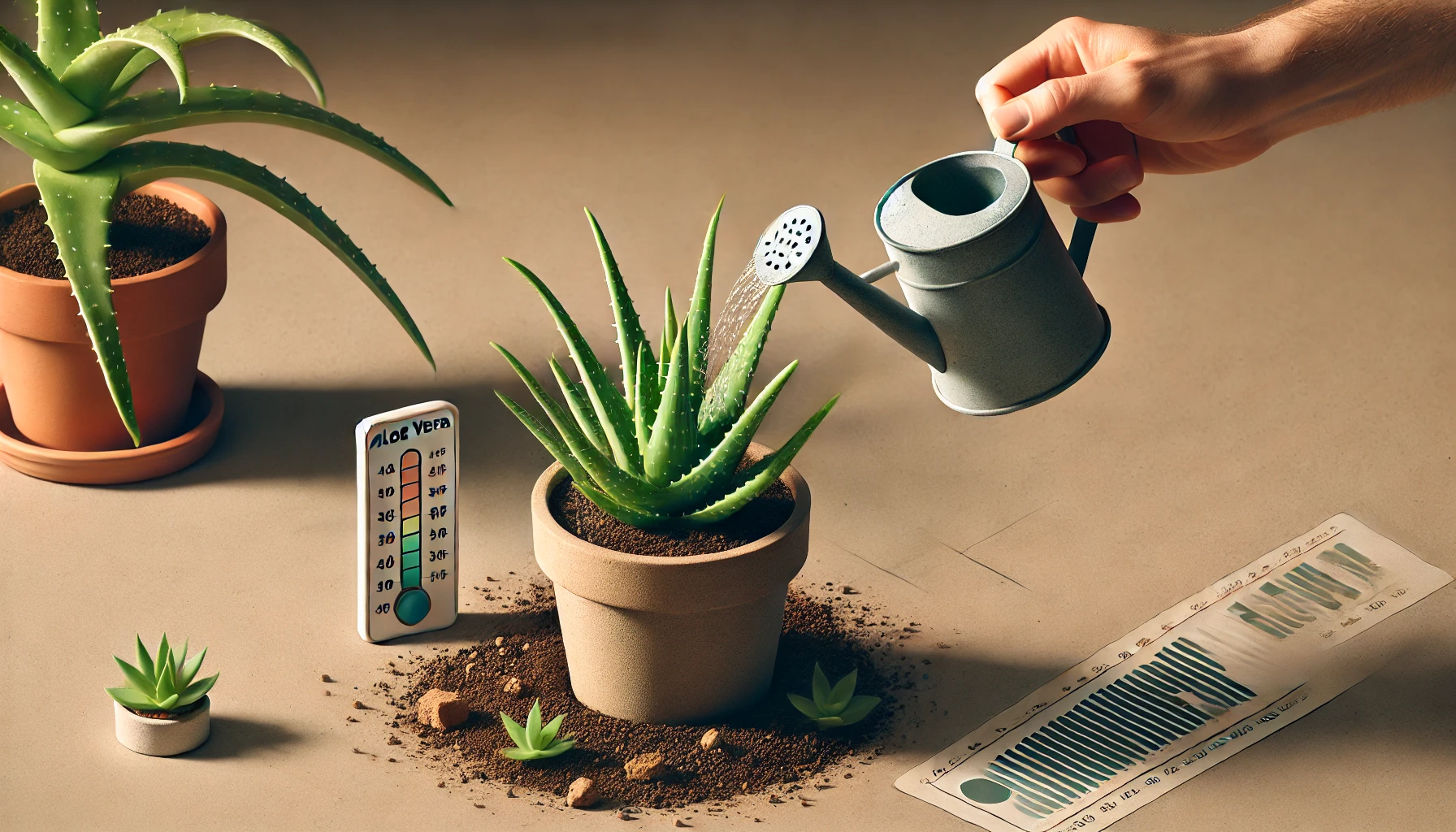
Signs of Overwatering:
Watch for signs like yellowing or mushy leaves, which indicate too much moisture. In low light, Aloe Vera’s ability to use water diminishes, so it’s crucial to avoid soggy soil.
Proper Drainage:
Ensure your Aloe Vera is planted in well-draining soil and a pot with drainage holes. This allows excess water to escape, preventing water from pooling at the bottom and causing root rot.
Watering Technique:
When you water, do so thoroughly, ensuring the entire root system gets hydrated. However, always make sure the pot drains completely to avoid water retention in the soil.
Adjusting Watering in Winter:
In low-light conditions, especially during the winter months when the plant is less active, reduce the frequency of watering even further. Aloe Vera may only need watering once every 3-4 weeks during this time.
By following these watering tips, you can keep your Aloe Vera healthy and thriving, even in low-light conditions. Just remember, less is more when it comes to watering in these environments!
Soil and Drainage Considerations
When it comes to plant health, soil and drainage are crucial factors. Proper soil ensures your plant has the nutrients it needs, while good drainage prevents waterlogged roots and promotes healthy growth.
Soil Type:
Most plants prefer well-draining, loamy soil that retains some moisture but allows excess water to flow through easily. A good mix for most houseplants includes peat, perlite, and pine bark. For succulent and cactus plants, use a mix that includes sand or grit to enhance drainage.
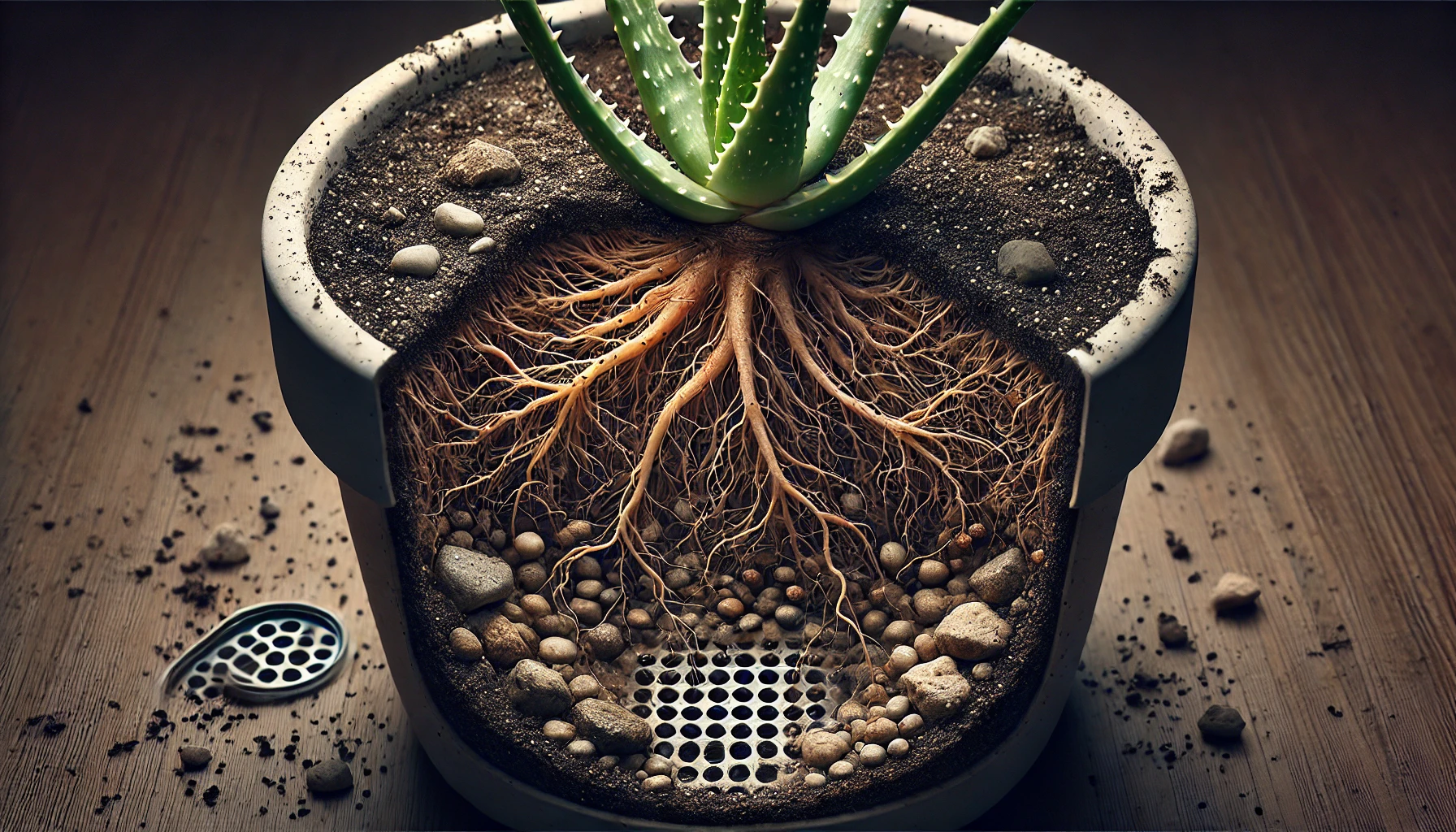
Drainage Needs:
Adequate drainage is essential for preventing root rot. Always choose a pot with drainage holes to allow excess water to escape. If your pot doesn’t have holes, consider adding a layer of gravel or small stones at the bottom to improve drainage.
Choosing the Right Soil:
- For flowering plants, a slightly acidic to neutral soil (pH 6.0–7.0) is ideal.
- Cacti and succulents need a well-draining, sandy or gritty mix.
- For tropical plants, use a rich, moisture-retaining mix that still drains well.
Repotting Tips:
When repotting, always use fresh, well-draining soil to avoid compacted or old soil that may retain too much moisture. Choose a pot that’s slightly larger than the root ball to allow for healthy root expansion.
Watering with Proper Drainage:
Even with the right soil, always water thoroughly but avoid letting plants sit in standing water. Empty saucers beneath pots after watering to prevent root damage from excess moisture.
By focusing on the right soil and drainage practices, you set the foundation for your plant’s success and growth.
Fertilizing Aloe Vera in Minimal Sunlight
Aloe Vera is a hardy plant, but when grown in minimal sunlight, it requires special care, especially when it comes to fertilizing. If your Aloe Vera is receiving less light than usual, proper fertilization can help keep it healthy and encourage growth.
Best Time to Fertilize:
Fertilize your Aloe Vera during its active growing season, typically in the spring and summer. Avoid fertilizing during the fall and winter when the plant is dormant, as this can lead to nutrient buildup and stress the plant.
Fertilizer Type:
Use a balanced, water-soluble fertilizer with a low nitrogen content (such as 10-10-10 or 5-10-5). Aloe Vera prefers a diluted fertilizer solution, so mix it at half the recommended strength to prevent overfeeding.
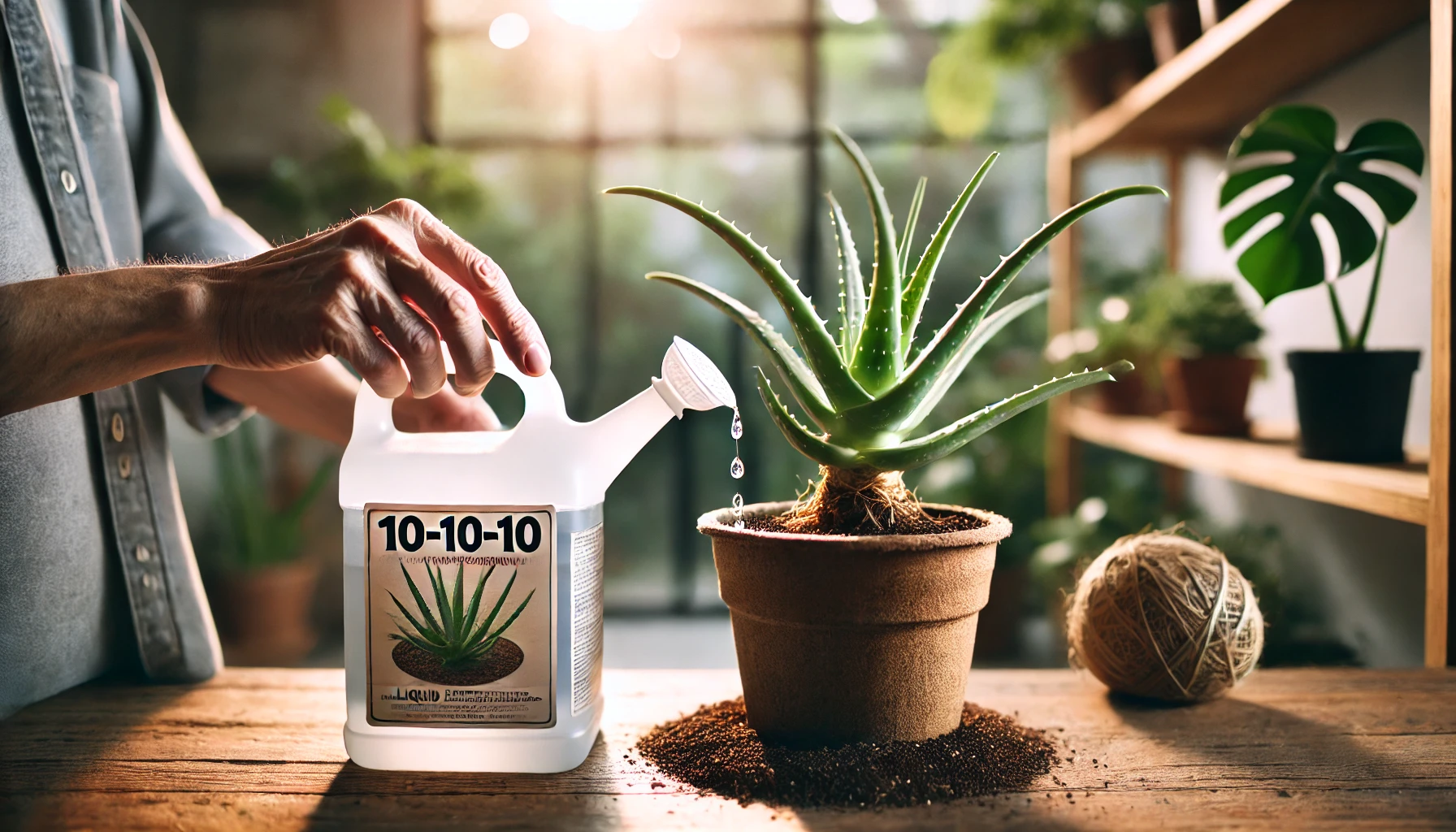
How Often to Fertilize:
Fertilize once every 4-6 weeks during the growing season. Over-fertilizing can lead to weak, leggy growth, especially in low-light conditions.
Watering and Fertilizing:
Always water your Aloe Vera before applying fertilizer to prevent root burn. Ensure the soil is slightly dry before fertilizing, and make sure the pot has proper drainage to avoid waterlogging.
Signs of Over-Fertilization:
If you notice yellowing leaves or stunted growth, you may be over-fertilizing. In such cases, flush the soil with water to remove excess fertilizer and allow the plant to recover.
By following these simple fertilizing tips, your Aloe Vera can thrive even in less-than-ideal light conditions. Keep the plant’s needs in balance, and it will remain a vibrant and healthy addition to your home.
Caring for Aloe Vera in minimal sunlight may seem challenging at first, but with the right approach, you can help your plant thrive even in less-than-ideal conditions. By understanding Aloe Vera’s light needs and adjusting your care routine—such as placing it in the right spot, watering properly, and using well-draining soil—you can ensure that your plant stays healthy and vibrant. While Aloe Vera may grow more slowly in low light, its resilience and beauty make it a perfect addition to any indoor space. With patience and attention, you’ll be able to enjoy the many benefits this versatile plant offers, even with minimal sunlight. Keep following the tips in this guide, and your Aloe Vera will be well on its way to healthy growth and longevity!
Frequently Asked Questions(FAQ)
Can Aloe Vera thrive in minimal sunlight?
Yes, Aloe Vera can survive in low-light conditions but may not thrive as vigorously as it would in full sunlight. Ensure it receives some indirect light and place it in a bright room, near a window with filtered light.
How much sunlight does Aloe Vera need to grow well?
Aloe Vera prefers bright, indirect sunlight. It requires at least 6 hours of indirect light daily for healthy growth. In minimal sunlight, it may grow more slowly but can still survive if properly cared for.
Can Aloe Vera survive without direct sunlight?
Aloe Vera can survive without direct sunlight, but it will not thrive. For optimal health, it is best to provide indirect light from a window, even if the sunlight is not direct.
How do I care for Aloe Vera if I don't have a sunny spot?
If you don’t have a sunny spot, try placing your Aloe Vera near a south or west-facing window where it will get bright, indirect light. You may also consider using a grow light to supplement the sunlight.
What should I do if my Aloe Vera is in minimal sunlight?
If your Aloe Vera is receiving minimal sunlight, reduce the watering frequency to prevent root rot. Aloe Vera is drought-tolerant, so it prefers less water, especially in low-light conditions. Ensure the soil is well-draining and allow it to dry out between waterings.
How do I know if my Aloe Vera is not getting enough sunlight?
Signs that your Aloe Vera is not getting enough sunlight include stretched or leggy growth, a pale or yellowing appearance, and slow or stunted growth. If you notice these signs, try moving your plant to a brighter location.
Can I use artificial light to help my Aloe Vera grow in minimal sunlight?
Yes, you can use artificial grow lights to supplement sunlight. Position the grow light around 6-12 inches above the plant for around 12 hours a day, ensuring it mimics natural light conditions.
How often should I water Aloe Vera in minimal sunlight?
In minimal sunlight, Aloe Vera requires less water because its growth slows down. Water it only when the soil is completely dry. Overwatering can lead to root rot, especially in low-light environments.
Can Aloe Vera produce gel in minimal sunlight?
Aloe Vera can still produce gel in minimal sunlight, but it may not be as abundant or as thick as in more ideal lighting conditions. Ensure your plant gets enough indirect light to encourage gel production.
Should I fertilize Aloe Vera in low-light conditions?
Fertilizing Aloe Vera in minimal sunlight should be done sparingly. During the growing season (spring and summer), you can fertilize once every 4-6 weeks with a diluted, balanced fertilizer. Avoid fertilizing in winter when the plant is dormant.
